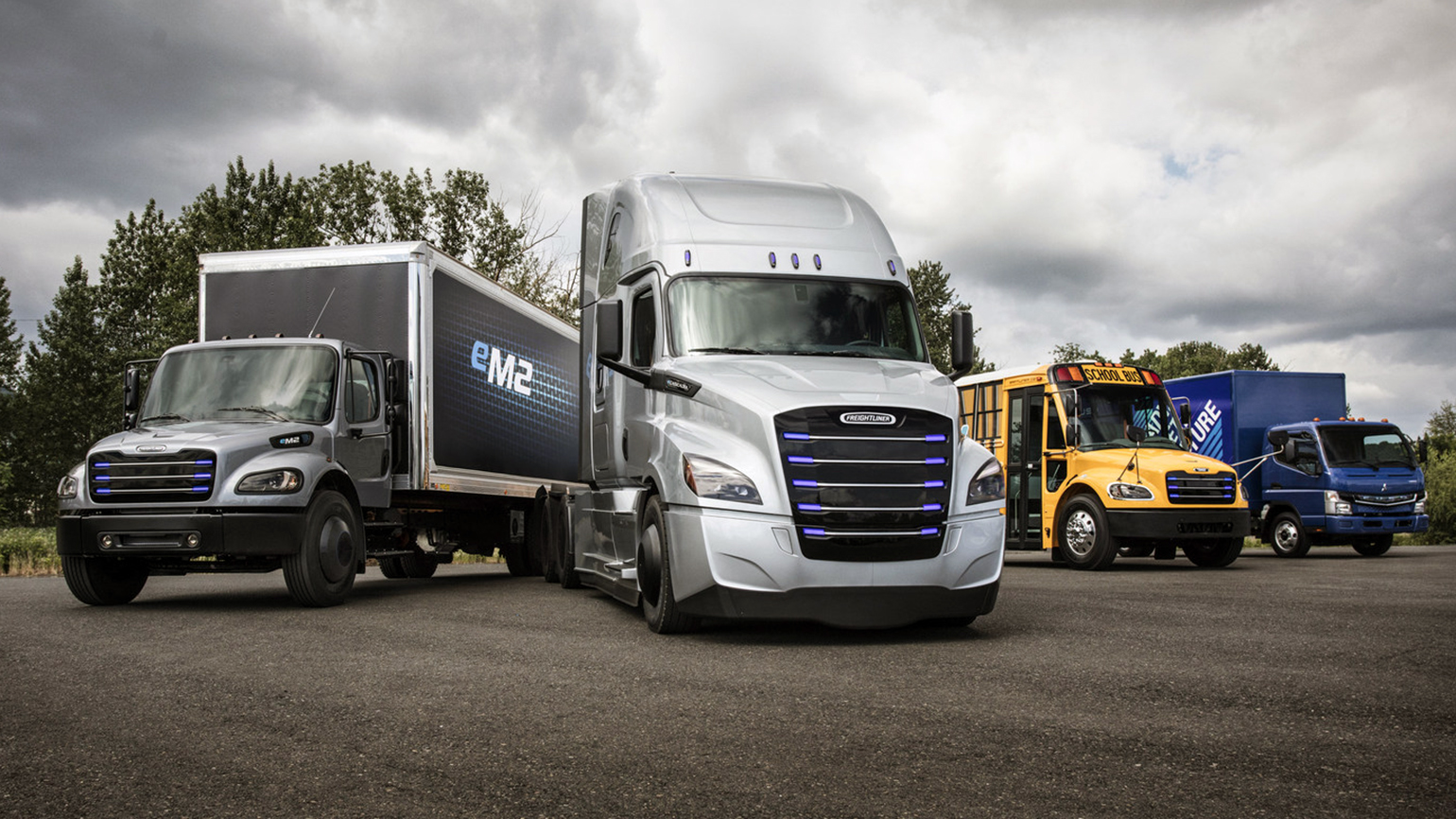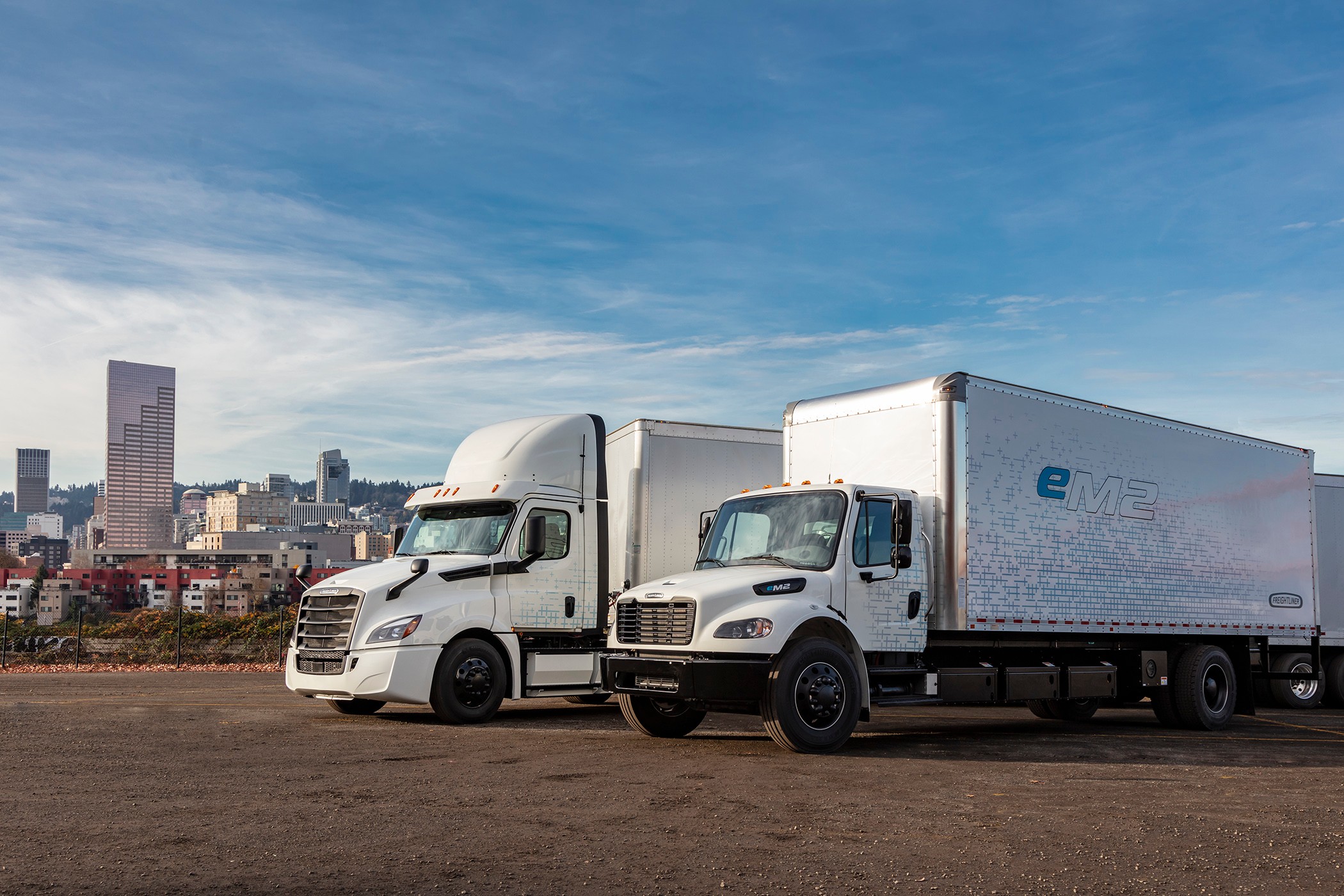Tesla Semi rival Freightliner recently revealed that its test fleet of all-electric commercial trucks has successfully crossed 700,000 miles of real-world travel. In part to several return-to-base type operations, including local and regional pick-up and delivery, Daimler Communications Manager Fred Ligouri detailed the trips and development of its eM2 box truck and eCascadia Class 8 tractor-trailer, the two vehicles responsible for the 700,000-mile travel statistic thus far.
The all-electric vehicle market is raging with competitors, and it goes far beyond the passenger car sector. With Tesla being the dominating force within electric passenger vehicles, fending off competition from several big-name manufacturers, the commercial vehicle sector is definitely wide open. Several companies are testing out all-electric commercial vehicles, and nobody has brought anything to the market that is being mass-produced at the moment. The Tesla Semi has been delayed on several occasions due to battery constraints, and other companies, like Nikola, have disappeared. It’s not to say that there won’t be a dominating company in this sector in the future, but up to this point, it is really anyone’s race.
Daimler Trucks’ line-up of commercial electric vehicles (from left to right): Freightliner eM2, Freightliner eCascadia, Thomas Built Buses Saf-T-Liner C2 Jouley, FUSO eCanter [Credit: Daimler North America]
With that being said, Freightliner believes they have what it takes to derail the hype that coincides with the Tesla Semi. After completing so many miles of real-world testing, Ligouri believes that Freightliner is moving closer to putting its all-electric trucks on the road as testing provides its engineers with valuable feedback from drivers who are giving honest opinions about the vehicles moving forward.
“These are real trucks hauling real freight in the real world and racking up zero-emissions mile after mile — in excess of 700,000 thus far,” Ligouri told Inverse. “Through this process of co-creation with our customers, we are ensuring durability and reliability for series-built trucks, incorporating purposeful innovations, and furnishing the opportunity for more and more fleets to experience eMobility.”
Freightliner is in no rush to put anything out before it’s absolutely ready. There are currently 38 preproduction trucks traveling around Southern California to develop modifications and improvements as the truck moves closer to its production stage. The testing phase is apart of Daimler’s Battery Electric Freightliner Customer Experience Fleet. Drivers are responsible for reporting suggestions, dislikes, and areas of improvement to the manufacturer, who considers each comment.
The trucks aren’t prepared for extremely-long and treacherous routes quite yet. The eM2 box truck packs only 230 miles of range, while the eCascadia can take drivers 250 miles per charge. It’s undoubtedly low compared to regular Semi-trucks, but it’s not to say that it won’t improve. And, after all, it travels with zero-emissions.
While Freightliner has an impressive statistic in its 700,000 miles of travel with its two all-electric trucks, it surely doesn’t have the only Semis on the road that are all-electric. The Tesla Semi has made some runs from Fremont, California, to Sparks, Nevada, and has been tested in real-world conditions as well. Additionally, several new sightings of the Tesla Semi have been reported recently, showing Tesla is undoubtedly working to pinpoint a date for a future production run of its all-electric commercial vehicle. After the recent promotion of Jerome Guillen from Automotive President to President of Heavy Trucking, it is evident Tesla is looking to make major strides in Semi development in 2021.

Cybertruck
Tesla Cybertruck undergoes interior mod that many owners wanted

Tesla Cybertruck is significantly different from traditional pickups on the market in a lot of ways. However, one feature that was recently modified with its interior was a highly requested characteristic that is present in other trucks, but was void from Cybertruck.
Tesla went with a five-seat configuration with Cybertruck: two in the front and three in the back. The spacious interior is matched with plenty of storage, especially up front, as a pass-through, center console, and other storage options, but some Tesla fans wanted something different: bench seating.
Bench seating is popular in many full-size pickups and allows three passengers to sit up front. The middle seat is usually accompanied by a fold-down storage unit with cupholders.
Tesla decided to opt for no bench seating up front, despite the fact that it equipped bench seating in the unveiling in 2019. Interior photos from the unveiling event from nearly six-and-a-half years ago show Tesla had originally planned to have a six-seat configuration.
This was adjusted after the company refined the design:

(Tesla Cybertruck interior configuration in 2019)
Despite Tesla abandoning this design, it does not mean owners were willing to accept it. One owner decided to modify their Tesla Cybertruck interior to equip that third seat between the driver’s and passenger’s thrones.
The fit is snug, and while it looks great, it is important to remember that this does not abide byregulations, as it would require an airbag to be technically legal. Please do not do this at home with your own Cybertruck:
- Credit: @blueskykites
- Credit: @blueskykites
- Credit: @blueskykites
The Cybertruck is a popular vehicle in terms of publicity, but its sales have been underwhelming since first delivered to customers back in 2023. It’s hard to believe it’s been out for two-and-a-half years, but despite this, Tesla has not been able to come through on its extensive order sheet.
This is mostly due to price, as Cybertruck was simply not as affordable as Tesla originally planned. Its three configurations were initially priced at $39,990, $49,990, and $69,990. At release, Cybertruck was priced above $100,000.
This priced out many of those who had placed orders, which is the main reason Cybertruck has not lived up to its expectations in terms of sales. The adjustments to the specific features, like the removal of the bench seat, likely did not impact sales as much as pricing did.
This modification shows some creativity by Tesla owners, but also shows that the Cybertruck could always be the subject of a potential refresh to include some of these features. Tesla routinely adjusts its vehicle designs every few years, so maybe the Cybertruck could get something like this if it chooses to refresh its all-electric pickup.
Elon Musk
Tesla CEO Elon Musk drops massive bomb about Cybercab
“And there is so much to this car that is not obvious on the surface,” Musk said.

Tesla CEO Elon Musk dropped a massive bomb about the Cybercab, which is the company’s fully autonomous ride-hailing vehicle that will enter production later this year.
The Cybercab was unveiled back in October 2024 at the company’s “We, Robot” event in Los Angeles, and is among the major catalysts for the company’s growth in the coming years. It is expected to push Tesla into a major growth phase, especially as the automaker is transitioning into more of an AI and Robotics company than anything else.
The Cybercab will enable completely autonomous ride-hailing for Tesla, and although its other vehicles will also be capable of this technology, the Cybercab is slightly different. It will have no steering wheel or pedals, and will allow two occupants to travel from Point A to Point B with zero responsibilities within the car.
Tesla shares epic 2025 recap video, confirms start of Cybercab production
Details on the Cybercab are pretty face value at this point: we know Tesla is enabling 1-2 passengers to ride in it at a time, and this strategy was based on statistics that show most ride-hailing trips have no more than two occupants. It will also have in-vehicle entertainment options accessible from the center touchscreen.
It will also have wireless charging capabilities, which were displayed at “We, Robot,” and there could be more features that will be highly beneficial to riders, offering a full-fledged autonomous experience.
Musk dropped a big hint that there is much more to the Cybercab than what we know, as a post on X said that “there is so much to this car that is not obvious on the surface.”
And there is so much to this car that is not obvious on the surface
— Elon Musk (@elonmusk) January 2, 2026
As the Cybercab is expected to enter production later this year, Tesla is surely going to include a handful of things they have not yet revealed to the public.
Musk seems to be indicating that some of the features will make it even more groundbreaking, and the idea is to enable a truly autonomous experience from start to finish for riders. Everything from climate control to emergency systems, and more, should be included with the car.
It seems more likely than not that Tesla will make the Cybercab its smartest vehicle so far, as if its current lineup is not already extremely intelligent, user-friendly, and intuitive.
Investor's Corner
Tesla Q4 delivery numbers are better than they initially look: analyst
The Deepwater Asset Management Managing Partner shared his thoughts in a post on his website.

Longtime Tesla analyst and Deepwater Asset Management Managing Partner Gene Munster has shared his insights on Tesla’s Q4 2025 deliveries. As per the analyst, Tesla’s numbers are actually better than they first appear.
Munster shared his thoughts in a post on his website.
Normalized December Deliveries
Munster noted that Tesla delivered 418k vehicles in the fourth quarter of 2025, slightly below Street expectations of 420k but above the whisper number of 415k. Tesla’s reported 16% year-over-year decline, compared to +7% in September, is largely distorted by the timing of the tax credit expiration, which pulled forward demand.
“Taking a step back, we believe September deliveries pulled forward approximately 55k units that would have otherwise occurred in December or March. For simplicity, we assume the entire pull-forward impacted the December quarter. Under this assumption, September growth would have been down ~5% absent the 55k pull-forward, a Deepwater estimate tied to the credit’s expiration.
“For December deliveries to have declined ~5% year over year would imply total deliveries of roughly 470k. Subtracting the 55k units pulled into September results in an implied December delivery figure of approximately 415k. The reported 418k suggests that, when normalizing for the tax credit timing, quarter-over-quarter growth has been consistently down ~5%. Importantly, this ~5% decline represents an improvement from the ~13% declines seen in both the March and June 2025 quarters.“
Tesla’s United States market share
Munster also estimated that Q4 as a whole might very well show a notable improvement in Tesla’s market share in the United States.
“Over the past couple of years, based on data from Cox Automotive, Tesla has been losing U.S. EV market share, declining to just under 50%. Based on data for October and November, Cox estimates that total U.S. EV sales were down approximately 35%, compared to Tesla’s just reported down 16% for the full quarter. For the first two months of the quarter, Cox reported Tesla market share of roughly a 65% share, up from under 50% in the September quarter.
“While this data excludes December, the quarter as a whole is likely to show a material improvement in Tesla’s U.S. EV market share.“













